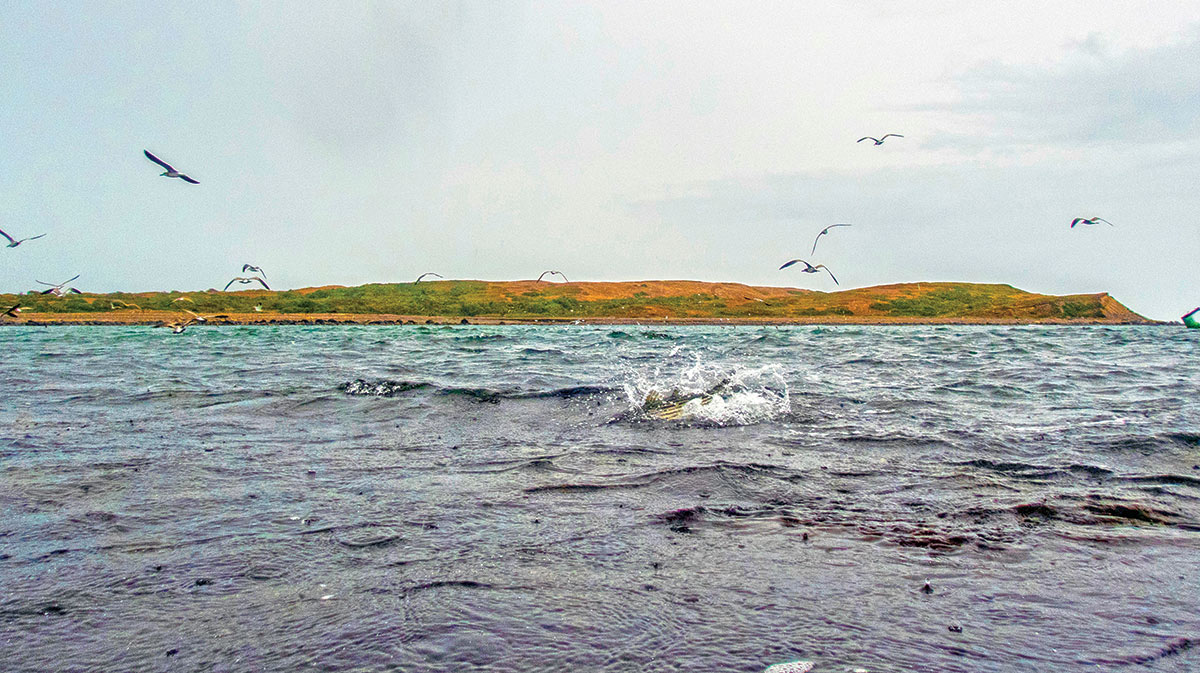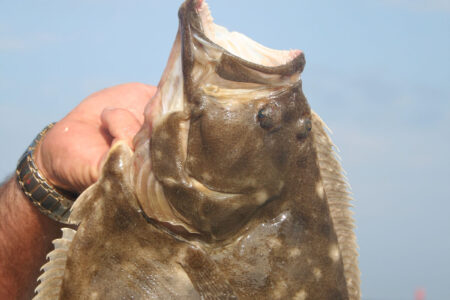
Put glide baits to use when you find that next big fall blitz of bass and blues.
There’s nothing quite like standing on shore with hundreds or thousands of fish blasting bait out of the water mere feet in front of me. The energy, chaos and visual aspects of an inshore “blitz” are intoxicating. Conversely, often the most frustrating days fishing are when I have a seemingly endless glut of fish in front of me but I cannot catch a single one! Sometimes I could almost reach down and grab them, but cast after cast, they snub my offering and leave me ready to throw my rod into the surf. A similar scenario, albeit somewhat less frustrating, is when I see large fish slashing and attacking bait, yet all I’m catching is small schoolies.
This seems to happen more than one would think. If you have a few years fishing the salt under your belt, you may have experienced it. However, I always believe there’s a way around it; after all, the fish are there and feeding with reckless abandon, so the hard part is taken care of. Yet, despite the fish not taking their offering, some anglers insist on just casting the same plug or two over and over into the melee, hoping something will change. What they are thinking I can only guess, but I believe they assume that because the fish are feeding aggressively that it’s just a matter of time before they catch something.
This is not a good tactic. Waiting for the fish to cooperate is inviting the skunk—you need to go on the offensive and figure out what they want. Even if I’m catching a fish every handful of casts in a blitz, I’m not content. If the fish are going bananas at my feet, I should be hooking up every cast. One way I have recently begun to increase my catch numbers in these classic fall blitzes is to fish glide baits heavily. Sometimes called stick baits, these plugs are the perfect blitz busting plugs.
Glide baits originated in freshwater fishing—specifically musky fishing—and they quickly became popular with fishermen at the Cape Cod Canal. While they have proven to be extremely successful for anglers up and down the coast, they remain somewhat underutilized by the masses. So much so, I believe I’m letting you in on a personal secret that allows me to out-fish poppers, tins and swimmers by as much as 20 to 1.
Why Glide Baits?
First, glide baits are versatile. Many assume they are only good for areas with current. This is inaccurate. I use them everywhere: on sand beaches, in boulder fields, in big surf, and calm backwaters. The glide baits I use can be fished many different ways: fast and loose, or slow and low, and everything in-between. This is a huge advantage over the ubiquitous poppers used by most anglers during day time blitzes—glide baits can be implemented essentially anywhere, at any time. During a daytime blitz, I start by fishing glide baits with a moderate retrieve and a rapid tip action similar to how I work a pencil, but with smaller jerks of the rod. This puts the glide bait just below the surface, or waking on the surface, making a lot of commotion. Worked with slower tip action, the plug will begin to shoot rhythmically back and forth subsurface, like an underwater spook plug. The action will vary with the specific plug you’re using, but this hyper-erratic motion seems to really draw the fish when surface plugs and swimmers are coming up short.

I also rely heavily on working both small and large glide baits slowly with sharp, random, jerks and twitches. This seems especially effective if stripers and blues are on bunker, or larger baits, where the predators sit below the forage fish waiting for the injured individuals to fall out of the school. Casting a glide bait out, letting it sink for a moment (or longer!) and then working it slowly with erratic twitches, seems to be irresistible to cow bass, and I have landed more than a few big fish using this technique. Just hold on when you twitch it, because that’s nearly always when the hit comes, and it is often violent!
Next, glide baits are deep, big-profile plugs. Even if you’re using the small 1-ounce Sebile Stick Shadd, it is relatively deep for its length. This is in contrast to many other plugs like the SP minnow or a pencil popper, which are slender profiles. This can be a huge advantage if the fish are on deep-bodied baits such as peanut bunker, adult bunker, snapper blues, mullet, etc. However, even if they aren’t, the deeper profile can attract the attention necessary to garner a strike when the surf is a proverbial soup of bait and predators. For example, I was on a spearing blitz last year where the fish were especially picky. Poppers and bucktails were useless, and while I could get them to hit an SP Minnow, the cast-to-hook-up ratio was only about 10:1. Frustrated, I put on a small glide bait and began hooking-up every cast. In this situation, I believe the glide bait was cutting through the noise and making itself seen.
Further, the fat, large profile of a glide bait seems to attract bigger fish. This past September I was fishing a blitz where bass were attacking silver-dollar sized peanut bunker. The bass would roll into the surf riding the white water of a wave, and I only had a short moment to cast to them before they sped back out to deeper water. I started with a small spook plug, and I was immediately into schoolies on every cast. After catching a couple dozen, I began to get bored, and decided to try a glide bait. My first cast was rewarded with a fish pushing 15 pounds, and I landed several more to low-teens. This repeated for three days in a row—schoolies on spooks and poppers, bigger fish on glide baits. I would have had no idea if I hadn’t decided to try the glide bait. It always pays to experiment.
Another key to the blitz-busting capacity of the glide bait is they cast phenomenally. They are no tin, but they cast about as far as a comparable popper. And the larger sizes cast as well as the smaller sizes if used with properly-sized gear. This makes them especially effective if you find yourself on an adult bunker blitz, but the fish are on an outer bar, or if you’re casting into a strong on-shore wind. While a metal lip might be a perfect plug when the fish are on big bunker, good luck casting one into a 30mph on-shore wind. And if the fish won’t take a popper, glide baits offer a similar profile as a metal lip and easily cast twice or three times the distance. Add in the versatility in which you can fish them, and you’ll be hard-pressed to find a plug that is better suited for these “bait on the bar” situations.
Finally, glide baits offer another advantage in blitz situations: they can be fished with single trebles or two inline hooks. Whichever you use, it makes no difference in the action or fishablility of the plug, and may even slightly increase the casting distance. When I’m fortunate enough to be in a blitz situation, I want to be able to get the fish off the plug as quickly and safely as possible so I can get back in on the action fast. Fishing with a single hook makes releases much easier on the angler and fish. Wasting time unhooking rear trebles from smaller fish is especially frustrating, and has led to more than a few injuries to my hands and the fish.
Glide Bait Options
I mainly rely on readily-available plastic glide baits. In my plug bag you’ll find the following: the suspending 1-ounce Sebile Stick Shadd, the 1-1/2-ounce Savage Gear Freestyler, the 3-1/4-ounce Freestyler (a personal favorite), and the 3- and 4-ounce slow-sink Sebile Stick Shadds. Sebile offers a staggering array of sizes and weights, and I have used others than those listed, but find the above to be my favorites. It is easy to pack several of these plugs as even the largest slides between the tubes in most surf bags.

A few notes about these plugs. The small Sebile is not through-wired so one must be cautious with drag pressure. I’ve yet to break one, but I’ve bent the hanger substantially even on smaller fish. However, it is the perfect peanut imitator, and worth its small space in your bag. The Savage Gear Freestyler plugs are overall my favorite. They are inexpensive, come with two sets of strong forged hooks and have a thick profile that produces excellent action. For me, they are the more versatile of the two brands. Savage is coming out with a new line of Mackerel glide baits this fall that look phenomenal, but I have yet to test them. The larger Sebiles in slow-sink still sink faster than the Savages, but they cast better, and the increased sink rate makes them useful in a strong surf or current sweep. The fast-sink models are less useful where I fish, but have their time and place in Nor’Easter storm situations.
In addition to the glide baits produced by Sebile and Savage Gear as noted above, several other manufacturers produce similar plugs in plastic form. The Yo-Zuri Diving Slider was produced with pelagics in mind so it has the strength to stand up to most inshore gamefish and produces a great sub-surface side-to-side swim. Rapala produces several glide baits in the X-Rap Saltwater SubWalk, X-Rap Twitchin’ Minnow and X-Rap Long Cast Shallow, Williamson makes the SubSurface Pro, Strategic Angler produces some great crossover glides that work both inshore and off, and Tsunami will be introducing the Surface Striker this winter. On the wooden side, glide baits have become the “in” lure for garage builders to produce the last few years. Several options include glides produced by Fatty Lures, Loki Lures, Surf Asylum, RM Smith and others.
The list goes on and on for plastic and wooden glide baits, so don’t be afraid to try different manufacturers to see what works best for you; just make sure you have a few of these versatile plugs in your bag for the last of the late fall blitzes!




